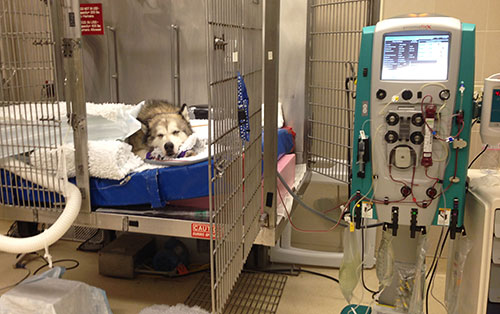
Leslie Huber’s seven-year-old dog, an Alaskan malamute named Shmoo, had developed serious kidney problems, and after six days of treatment had shown no improvement. In the past, there might not have been another step to take. But a new treatment — continuous renal replacement therapy (CRRT) — is now available at the Ontario Veterinary College’s Health Sciences Centre (OVC HSC).
The procedure temporarily takes over the function of the kidneys by pumping blood from the animal’s body to an external filter that removes waste products from the blood. The blood is then returned to the animal’s system. The therapy is used for acute kidney failure, which can be caused by disease, shock, low blood pressure or eating plants or foods that are toxic to the animal — for example, raisins and grapes will damage kidneys in dogs and lilies are equally harmful to cats.
“OVC’s HSC is the first animal hospital in Canada to offer this form of dialysis to cats and dogs,” says Alexa Bersenas, chief of the emergency and critical care service at HSC.
The therapy requires meticulous setup, standard operating procedures and thorough training. All HSC intensive care unit (ICU) staff members, including registered veterinary technicians and residents, have been trained on the new therapy, she adds.
A veterinarian herself, Huber recognized the therapy couldn’t guarantee a full recovery, but it was the only option that might give Shmoo’s kidneys time for repair, and provide an improved quality of life. “It was a risk, but we had to give it a shot,” says Huber.
“CRRT isn’t a long-term medical solution for chronic renal failure,” adds Bersenas. She explains CRRT provides time for the kidneys to recover to their full potential.
The OVC’s ICU is ideally suited to provide this therapy with highly qualified personnel available 24 hours a day. “Manpower is vital,” adds Bersenas. “This therapy needs a tremendous amount of support.”
As with any intensive therapy, the final outcome of CRRT is variable. In some cases, a full recovery is possible, and patients go on to live happy healthy lives; in other circumstances CRRT can extend a pet’s life. That was the case for Shmoo. After her therapy, Shmoo was home for Christmas and rang in the New Year with Huber. That wouldn’t have been possible without CRRT.
“This is Shmoo’s legacy,” Huber says. “If we get a day, a week, a month — every day is a gift.”